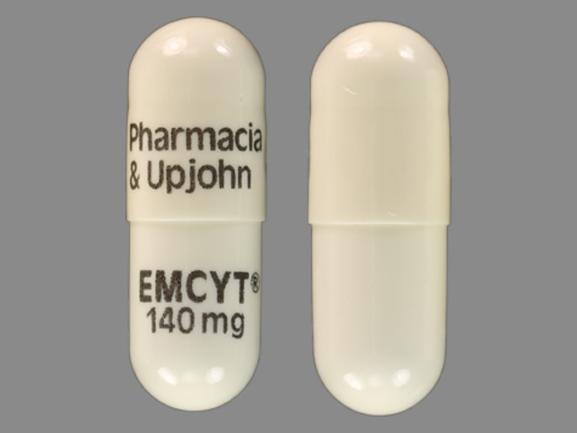Estramustine Disease Interactions
There are 9 disease interactions with estramustine.
- Hypertension
- Thromboembolism/cardiovascular
- Abnormal vaginal bleeding
- Hypercalcemia in breast cancer
- Hypercalcemia
- Liver disease
- Fluid retention
- Glucose intolerance
- Thyroid function tests
Estramustine (applies to estramustine) hypertension
Major Potential Hazard, High plausibility.
The risk of myocardial infarction and strokes, including those associated with estrogen use, may be increased in patients with hypertension. Moreover, estramustine may elevate blood pressure and worsen the hypertension, thus compounding the risk. Therapy with estramustine should be administered cautiously in patients with preexisting hypertension. Patients should be monitored for changes in cardiovascular status, and their antihypertensive regimen adjusted as necessary.
Estramustine (applies to estramustine) thromboembolism/cardiovascular
Major Potential Hazard, High plausibility. Applicable conditions: Ischemic Heart Disease, Cerebral Vascular Disorder, Thrombotic/Thromboembolic Disorder, History - Thrombotic/Thromboembolic Disorder
The use of estramustine, a combination of estradiol and nornitrogen mustard, is contraindicated in patients with active thrombotic or thromboembolic disorders, unless the tumor mass is thought to be the source of these conditions. Estrogens, particularly in high dosages, can increase the risk of thrombotic events, myocardial infarction, and strokes. Therapy with estramustine should be administered cautiously and only after careful consideration of risks and benefits in patients with cerebrovascular disease, coronary artery disease, or a history of thrombotic or thromboembolic disorders.
Estrogens (applies to estramustine) abnormal vaginal bleeding
Major Potential Hazard, High plausibility. Applicable conditions: Abnormal Uterine Bleeding
The use of estrogens is contraindicated in patients with undiagnosed, abnormal vaginal bleeding. Prolonged (> 1 year), unopposed estrogen use (i.e. estrogen without concomitant progestin therapy) has been associated with a significant, dose-related risk of endometrial carcinoma. The risk may be offset substantially by the addition of a progestin but may not be completely abolished. Prior to initiating estrogen therapy, appropriate diagnostic tests should be performed in patients with abnormal vaginal bleeding to rule out endometrial malignancy. The same applies if recurrent or persistent bleeding develops during estrogen therapy.
Estrogens (applies to estramustine) hypercalcemia in breast cancer
Major Potential Hazard, Moderate plausibility.
When treated with an estrogen, patients with breast cancer and bone metastases may develop severe hypercalcemia, in which case the drug should be stopped and measures be taken to reduce serum calcium levels.
Estramustine (applies to estramustine) hypercalcemia
Moderate Potential Hazard, Moderate plausibility. Applicable conditions: Renal Dysfunction, Hyperparathyroidism
Estramustine influences the metabolism of calcium and phosphorus. Intestinal absorption and retention of calcium are increased, which may occasionally result in hypercalcemia. Therapy with estramustine should be administered cautiously in patients with preexisting hypercalcemia, renal dysfunction, or metabolic bone diseases that are associated with hypercalcemia.
Estrogens (applies to estramustine) liver disease
Moderate Potential Hazard, High plausibility.
Estrogens are primarily metabolized by the liver. Use of estrogen therapy is contraindicated in patients with liver dysfunction or disease. Patients with impaired hepatic function may be at increased risk for adverse effects associated with estrogen administration due to decreased drug clearance. Patients with hepatic hemangiomas are at increased risk of exacerbation with use of estrogens. Therapy with estrogens should be administered cautiously in patients with cholestatic jaundice associated with past estrogen use or with pregnancy. In addition, clinicians should be aware that estrogen therapy may affect liver function tests.
Estrogens/progestogens (applies to estramustine) fluid retention
Moderate Potential Hazard, High plausibility. Applicable conditions: Asthma, Renal Dysfunction, Congestive Heart Failure, Migraine, Seizures
Estrogens and progestogens may cause fluid retention, particularly when given in high dosages or for prolonged periods. Therapy with these agents should be administered cautiously in patients who have preexisting problems with excess fluid. In addition, patients with conditions that may be adversely affected by fluid accumulation, such as asthma, epilepsy, migraine, and cardiovascular or renal dysfunction, should be observed for exacerbation of their condition during estrogen and/or progestogen therapy.
Estrogens/progestogens (applies to estramustine) glucose intolerance
Moderate Potential Hazard, Moderate plausibility. Applicable conditions: Diabetes Mellitus
Impaired glucose tolerance has been observed in some patients administered oral contraceptives and appears to be related primarily to the estrogen dose. However, progestogens can increase insulin secretion and produce insulin resistance to varying degrees, depending on the agent. Caution and close monitoring are recommended in patients with diabetes mellitus during therapy with estrogens and/or progestogens, and adjustments made accordingly in their antidiabetic regimen.
Estrogens/progestogens (applies to estramustine) thyroid function tests
Moderate Potential Hazard, Moderate plausibility. Applicable conditions: Thyroid Disease
When administering estrogen and/or progestogen therapy in patients with thyroid disorders, clinicians should be aware that these hormones may affect thyroid function tests. Changes have mostly been reported with the use of combination oral contraceptives. Specifically, thyroid-binding globulin (TBG) may be increased, resulting in elevated circulating total thyroid hormone, as measured by PBI (protein-bound iodine), T4 by column or radioimmunoassay, or T3 by radioimmunoassay. Free T3 resin uptake may be decreased. On the contrary, a decrease in TBG and, consequently, thyroxine concentration, has been reported by the manufacturers of the progestin-only (norethindrone) oral contraceptives. Patients on thyroid replacement therapy may require higher doses of thyroid hormone and appropriate monitoring.
Switch to professional interaction data
Estramustine drug interactions
There are 140 drug interactions with estramustine.
Estramustine alcohol/food interactions
There are 2 alcohol/food interactions with estramustine.
More about estramustine
- estramustine consumer information
- Check interactions
- Compare alternatives
- Reviews (1)
- Side effects
- Dosage information
- During pregnancy
- Drug class: hormones/antineoplastics
- En español
Related treatment guides
Drug Interaction Classification
| Highly clinically significant. Avoid combinations; the risk of the interaction outweighs the benefit. | |
| Moderately clinically significant. Usually avoid combinations; use it only under special circumstances. | |
| Minimally clinically significant. Minimize risk; assess risk and consider an alternative drug, take steps to circumvent the interaction risk and/or institute a monitoring plan. | |
| No interaction information available. |
See also:
Further information
Always consult your healthcare provider to ensure the information displayed on this page applies to your personal circumstances.


